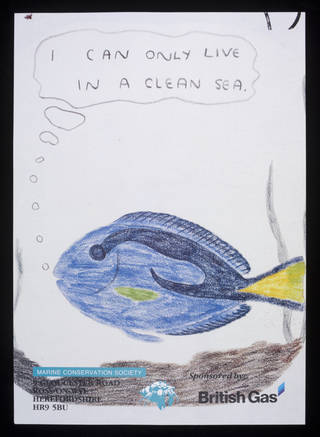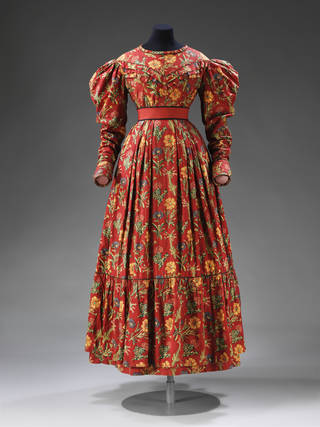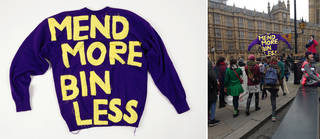The natural world is a constant source of inspiration for textile and fashion designers. The results can be joyous, colourful and highly desirable, yet their instant appeal makes it all too easy to forget the damage the fashion industry inflicts on nature. Today the industry's processes and practices often harm environments, ecosystems and human communities around the globe.
The modern linear system of manufacturing and the promotion of fast, disposable fashion puts pressure on non-renewable and threatened resources, especially water, and produces huge quantities of waste, most of which goes to landfill or for incineration. The industry's methods and materials can also be highly polluting. Its use of fossil fuels generates carbon dioxide that contributes to global warming by trapping heat in the atmosphere. Many dyeing and finishing processes rely on toxic chemicals that affect the health of workers and leach out into rivers and ground water systems degrading the land, compromising drinking water and killing fish. Synthetic fibres in the clothes we wear every day affect our oceans, rivers and marine life. When these clothes are washed tiny plastic microfibers too small to be trapped in filters enter not only the water system but also the food chain.

How has this happened?
The textile and fashion industry has always caused pollution but it increased dramatically in countries like Britain as the industry grew in scale during the 19th century. During this period, manufacturers utilised new technologies and faster manufacturing methods, particularly steam power, and retailers developed more sophisticated marketing and sales techniques. At the same time, the audience for fashion grew as the population increased, the middle class expanded, disposable incomes grew and prices fell. As the volume of manufacturing and consumption rose, so did air and water pollution.
Newspaper reports from the 19th century describe the foul conditions we now see in some developing countries. In 1833 the Manchester Times vividly evoked the stench and danger of the ‘Black Ditch’ at Pendleton which overflowed to flood the adjacent footpath with over a metre of mud contaminated with "waste dye stuff and filth" making it impassable and a public nuisance. The British government introduced legislation to control pollution from the 1860s but it was often flawed. Although government and industry recognised the link between poor health, environmental damage and pollution, these risks tended to be accepted as a necessary price of industrial development and manufacturers were reluctant to spend more than strictly necessary on pollution controls.

Manufacturing methods and the widespread use of toxic chemicals can also be hazardous. The new aniline dyes, developed in the second half of the 19th century, created bright, low cost colours but caused skin problems and, in some cases, an increased risk of cancer for those who worked with them. Some wearers suffered from sickness, swelling and rashes. The felt hatting industry was dangerous because most workshops used mercuric nitrate to speed up the felting process. Mercury can be absorbed through the lungs, skin and stomach and it stays in the body. Mercury poisoning affects the neuro-motor system, causing long-term tremors, anxiety and irritation. Our collection of hats that have been created using mercury are stored in labelled, sealed bags to contain any remaining toxic contaminants.
The environmental damage and occupational health hazards that were once common in Britain have now shifted elsewhere. The modern textile and fashion industry is global and most mass-manufacturing is outsourced to countries with low labour costs which often have weak labour and environmental laws.
The use of toxic chemicals remains a serious issue. In 2011 the environmental charity Greenpeace called the industry to account. Its Detox campaign challenges big clothing brands to take responsibility for the environmental impact of their supply chains and to commit to achieving zero discharges of hazardous chemicals by 2020. Only 80 companies signed up and progress has been made but they represent just 15% of the global industry.

What can we do to change this?
Today designers, scientists, business, government and campaigners are coming together to develop a range of high and low-tech solutions, tested and experimental, which together have the potential to create a cleaner, greener, less wasteful industry. Instead of the take, make, dispose model of the linear system of manufacturing, research is focussing on circular systems, which take, make and re-make.

Other approaches include reducing waste by designing products to be more durable and offering consumers the option of customisation; using sustainable materials like linen grown in Western Europe more widely; investing in the development of commercially viable methods of recycling blended materials, and converting waste from non-textiles sources like food into materials suitable for clothing and accessories; reducing carbon emissions by employing energy sources other than fossil fuels, using local centres of production and utilizing more energy efficient methods; reducing water consumption and the use of toxins in dyeing and finishing processes by developing new technologies; and developing bio-fabricated materials and alternative processes based in synthetic biology as an alternative to synthetic materials made in the petro-chemical industry.

As wearers, we can also make a difference by choosing and looking after our clothes more carefully, wearing them longer, having smaller wardrobes, re-cycling the clothes we no longer want and thinking about alternatives to buying such as swapping or renting outfits.

Find out more about the Fashioned From Nature exhibition.


